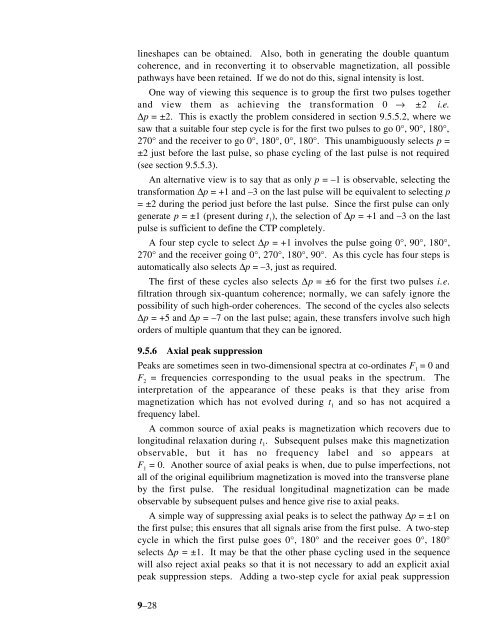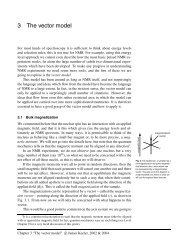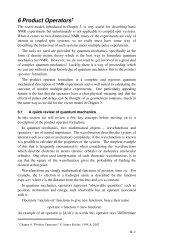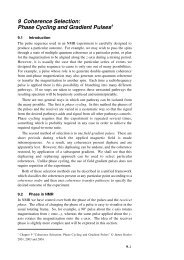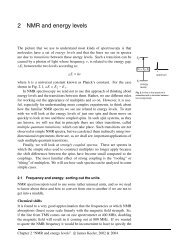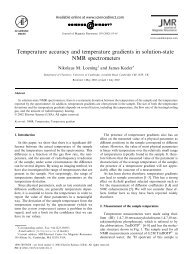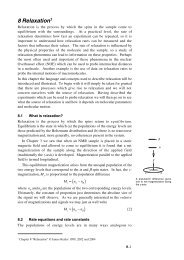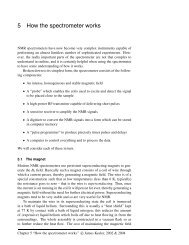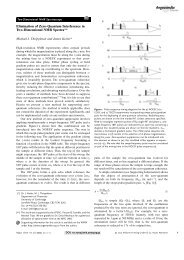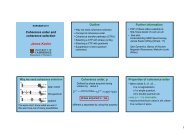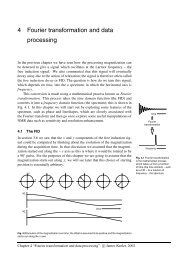Phase Cycling and Gradient Pulses - The James Keeler Group
Phase Cycling and Gradient Pulses - The James Keeler Group
Phase Cycling and Gradient Pulses - The James Keeler Group
You also want an ePaper? Increase the reach of your titles
YUMPU automatically turns print PDFs into web optimized ePapers that Google loves.
lineshapes can be obtained. Also, both in generating the double quantum<br />
coherence, <strong>and</strong> in reconverting it to observable magnetization, all possible<br />
pathways have been retained. If we do not do this, signal intensity is lost.<br />
One way of viewing this sequence is to group the first two pulses together<br />
<strong>and</strong> view them as achieving the transformation 0 → ±2 i.e.<br />
∆p = ±2. This is exactly the problem considered in section 9.5.5.2, where we<br />
saw that a suitable four step cycle is for the first two pulses to go 0°, 90°, 180°,<br />
270° <strong>and</strong> the receiver to go 0°, 180°, 0°, 180°. This unambiguously selects p =<br />
±2 just before the last pulse, so phase cycling of the last pulse is not required<br />
(see section 9.5.5.3).<br />
An alternative view is to say that as only p = –1 is observable, selecting the<br />
transformation ∆p = +1 <strong>and</strong> –3 on the last pulse will be equivalent to selecting p<br />
= ±2 during the period just before the last pulse. Since the first pulse can only<br />
generate p = ±1 (present during t 1<br />
), the selection of ∆p = +1 <strong>and</strong> –3 on the last<br />
pulse is sufficient to define the CTP completely.<br />
A four step cycle to select ∆p = +1 involves the pulse going 0°, 90°, 180°,<br />
270° <strong>and</strong> the receiver going 0°, 270°, 180°, 90°. As this cycle has four steps is<br />
automatically also selects ∆p = –3, just as required.<br />
<strong>The</strong> first of these cycles also selects ∆p = ±6 for the first two pulses i.e.<br />
filtration through six-quantum coherence; normally, we can safely ignore the<br />
possibility of such high-order coherences. <strong>The</strong> second of the cycles also selects<br />
∆p = +5 <strong>and</strong> ∆p = –7 on the last pulse; again, these transfers involve such high<br />
orders of multiple quantum that they can be ignored.<br />
9.5.6 Axial peak suppression<br />
Peaks are sometimes seen in two-dimensional spectra at co-ordinates F 1<br />
= 0 <strong>and</strong><br />
F 2<br />
= frequencies corresponding to the usual peaks in the spectrum. <strong>The</strong><br />
interpretation of the appearance of these peaks is that they arise from<br />
magnetization which has not evolved during t 1<br />
<strong>and</strong> so has not acquired a<br />
frequency label.<br />
A common source of axial peaks is magnetization which recovers due to<br />
longitudinal relaxation during t 1<br />
. Subsequent pulses make this magnetization<br />
observable, but it has no frequency label <strong>and</strong> so appears at<br />
F 1<br />
= 0. Another source of axial peaks is when, due to pulse imperfections, not<br />
all of the original equilibrium magnetization is moved into the transverse plane<br />
by the first pulse. <strong>The</strong> residual longitudinal magnetization can be made<br />
observable by subsequent pulses <strong>and</strong> hence give rise to axial peaks.<br />
A simple way of suppressing axial peaks is to select the pathway ∆p = ±1 on<br />
the first pulse; this ensures that all signals arise from the first pulse. A two-step<br />
cycle in which the first pulse goes 0°, 180° <strong>and</strong> the receiver goes 0°, 180°<br />
selects ∆p = ±1. It may be that the other phase cycling used in the sequence<br />
will also reject axial peaks so that it is not necessary to add an explicit axial<br />
peak suppression steps. Adding a two-step cycle for axial peak suppression<br />
9–28


